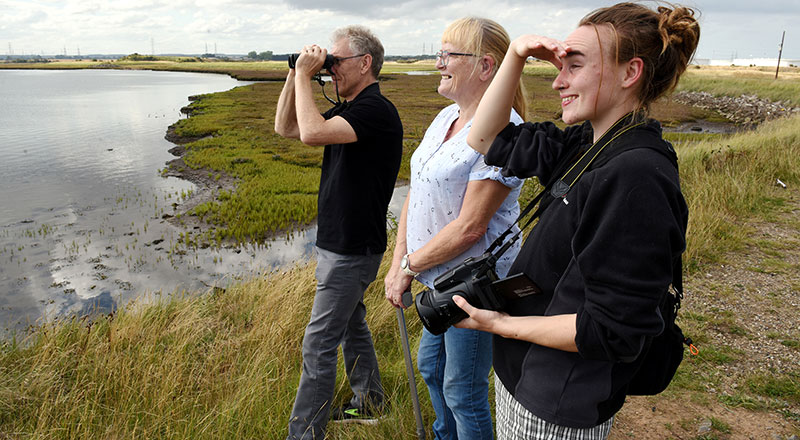
Now a four-year study is underway with the Industry Nature Conservation Association (INCA) and Teesside University to find out more about these lovable mammals and their habitat and behaviour.
Coinciding with the 30th anniversary of INCA’S Teesside Seal Monitoring Programme (TSMP), this year has seen record numbers of Harbour Seal pups being born on Teesside.
The TSMP was originally set up in 1989 to monitor the impacts of the Seal Distemper Virus that was devastating Harbour Seal numbers across the North Sea at that time. The programme was initially led by David Bellamy Associates but since 1992 INCA has co-ordinated it and monitored the numbers and behaviour of the seal population each year.
In that first year, only around 20 Harbour Seals and 20 Grey Seals were recorded, but those numbers have steadily crept up and, in recent years, maximum counts of almost 150 Harbour Seals are being hauled out over the summer.
Grey Seals are harder to count, but their numbers have also crept up and on occasion have reached in excess of 80.
For the first five years of the TSMP, no more than one seal pup was born each year and each of those died, with post-mortems revealing excessive levels of chemicals in their tissues. Since then, due in part to the river gradually becoming cleaner, the numbers of seal pups have risen by one or two each year and almost all pups now survive until they are weaned.
This year the number of pups born has surprised everyone - jumping from 26 last to 36. This is the biggest annual increase ever recorded in the number of seal pups born on Teesside.
The actual monitoring of the seals is done by a team of dedicated volunteers, who between them count the seals for two hours, every day for two months over the summer.
With over 30 years of monitoring, they will have amassed one of most extensive sets of data on mammal numbers anywhere.
The volunteer rota is co-ordinated by Linda Watson, who has been monitoring the seals for twenty years.
The seal populations around the Tees are truly wonderful, and we are glad to see their return to the area.
She said: “I have thoroughly enjoyed being part of the seal project. Over the years I have learnt so much about them, from the colours and characteristics of individual seals, to being able to watch females giving birth. It is fantastic to watch these beautiful creatures go about their daily life, and I will continue to do so for as long as I can.”
The monitoring wouldn’t be possible without the support of local company, Venator, who have enabled the construction of a seal hide on their land overlooking Seal Sands and who provide support to the volunteers when they are out surveying.
Gareth Williams, Environment Manager at Venator, said: “We are delighted to support INCA and their volunteers during the annual seal count. Seeing the numbers of pups increase year-on-year, and the seals thriving in general, makes me extremely proud of what together in Teesside we have achieved, clearly demonstrating that industry and nature can co-exist side by side.”
While the Teesside seal population is clearly a success, unravelling the factors behind that will require a lot more investigation.
Freya Pellie, a PhD researcher at Teesside University, working with INCA, has started a four-year study taking a more in-depth look at the seal’s biology. One of the focuses of the study is collecting seal faeces from their haul out locations and analysing their DNA content to understand, not only the population-relatedness and connectedness of the Teesmouth seal population, but also their diet and internal parasites.
The study’s supervisor, Dr Jamie Bojko, Senior Lecturer in Teesside University’s School of Health & Life Sciences, said: “The seal populations around the Tees are truly wonderful, and we are glad to see their return to the area. Hopefully, our work will help to unravel which populations support the Tees seals from outside of the area, and whether their diet and parasite load might help us to understand their success.”
Record number of seals found on Teesside's shores with new research underway to find out why
Coastal Views and Moor News, p.27, Print, 02/10/2022
The number of harbour seal pups being born in our region has hit record levels with over 200 seals now calling Teesside home.
Study launched as seal pup numbers hit record levels
Darlington and Stockton Times, p.53 , Print, 23/09/2022
The number of harbour seal pups being born in our region has hit record levels with over 200 seals now calling Teesside home.
Cleaner river hailed as seal pup numbers surge to record high
Yorkshire Post, p.7, Print and Web, 08/09/2022
Record numbers of harbour seal pups are being born on shores around the Tees partly because the river is getting cleaner, researchers say.
Record number of seal pups born on Teesside
ITV.com, Web, 08/09/2022
A four-year study is underway with the Industry Nature Conservation Association (INCA) and Teesside University to find out more about these lovable mammals.